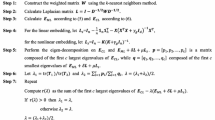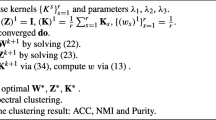Abstract
For existing kernel learning based semi-supervised clustering algorithms, it is generally difficult to scale well with large scale datasets and robust pairwise constraints. In this paper, we propose a new Non-Parametric Kernel Learning ( NPKL ) framework to deal with these problems. We generalize the graph embedding framework into kernel learning, by reforming it as a semi-definitive programming ( SDP ) problem, smoothing and avoiding over-smoothing the functional Hilbert space with Laplacian regularization. We propose two algorithms to solve this problem. One is a straightforward algorithm using SDP to solve the original kernel learning problem, dented as TRAnsductive Graph Embedding Kernel ( TRAGEK ) learning; the other is to relax the SDP problem and solve it with a constrained gradient descent algorithm. To accelerate the learning speed, we further divide the data into groups and used the sub-kernels of these groups to approximate the whole kernel matrix. This algorithm is denoted as Efficient Non-PArametric Kernel Learning ( ENPAKL ). The advantages of the proposed NPKL framework are (1) supervised information in the form of pairwise constraints can be easily incorporated; (2) it is robust to the number of pairwise constraints, i.e., the number of constraints does not affect the running time too much; (3) ENPAKL is efficient to some extent compared to some related kernel learning algorithms since it is a constraint gradient descent based algorithm. Experiments for clustering based on the learned kernels show that the proposed framework scales well with the size of datasets and the number of pairwise constraints. Further experiments for image segmentation indicate the potential advantages of the proposed algorithms over the traditional k-means and N-cut clustering algorithms for image segmentation in term of segmentation accuracy.






Similar content being viewed by others
Notes
Note that although we want to learn a kernel matrix from the aspect of graph embedding, it has little relationship with some algorithms using graph embedding framework such as marginal factor analysis (MFA) [6]. The reason is that such kinds of algorithms aim at supervised learning for classification, thus there is no need to compare the proposed algorithm with them.
We use such kind of convention without declaration below.
More satisfactory results might be attained if employing more sophisticated regularizers.
Note that for two positive semi-definite matrices A and B, \( tr\{AB\} \geq 0\) holds, but not always >0. We thus can not drop the last two constraints directly. Otherwise it is easy to run into numerical problem. Because the constraint still holds if 〈l p, K v 〉 is equal to a small enough positive constant, but this is far from the goal that 〈l p, K v 〉 should be as large as possible.
There are two points to be declared here. One is that it is easy to prove that K X in Eq. 32 is a positive semi-definite matrix if K D is positive semi-definite, this property makes K X of the whole dataset still be a kernel matrix, which does not violate our objective. The second point is that for unknown points, in order to constrain the feature space be a hyperball, we need to normalize the weights calculated in Eq. 30 by dividing the weights by a normalized scaler w T i K D w i , that is, \(w_i = \frac{w_i}{w_i^TK_Dw_i}. \)
This experiment was run on an Intel Core 2 Duo CPU T6400 2.00 GHZ with 2 GB of DDR2 memory
We used an efficient implementation of the N-cut algorithm in [38]
The k-means algorithm takes about 1 s for one image, the N-cut algorithm takes about 2 s, while ENPAKL needs about 5 min, and PCP cannot run in this experiment because the corresponding data is too large. How to accelerate the speed of the proposed algorithm further is our future work.
References
Chapelle O, Schölkopf B, Zien A (2006) Semi-supervised learning. MIT Press, Cambridge
Kulis B, Basu S, Dhillon I, Mooney R (2005) Semi-supervised graph clustering: a kernel approach. In: Proceedings of the 22nd international conference on machine learning, pp 457–464
Li Z, Liu J, Tang X (2008) Pairwise constraint propagation by semidefinite programming for semi-supervised classification. In: Proceedings of the 25th international conference on machine learning, pp 576–583
Yeung D-Y, Chang H, Dai G (2007) A scalable kernel-based algorithm for semi-supervised metric learning. In: Proceedings of the 20th international joint conference on artificial intelligence, pp 1138–1143
Cortes C, Mohri M, Rostamizadeh A (2009) Learning non-linear combinations of kernels. In: Advances in neural information processing systems, vol 21
Yan SC, Xu D, Zhang BY, Zhang H-J, Yang Q, Lin S (2007) Graph embedding and extensions: a general framework for dimensionality reduction. IEEE Trans Pattern Anal Mach Intell 29(1):40–51
Yang J, Yan SC, Fu Y, Li XL, Huang TS (2008) Non-negative graph embedding. In: Proceedings of IEEE computer society conference on computer vision and pattern recognition
Schölkopf B, Smola AJ (2001) Learning with kernels: support vector machines, regularization, optimization, and beyond. MIT Press, Cambridge
Cortes C, Mohri M, Rostamizadeh A (2010) Two-stage learning kernel algorithms. In: Proceedings of the 27th international conference on machine learning
Cortes C, Mohri M, Rostamizadeh A (2010) Generalization bounds for learning kernels. In: Proceedings of the 27th international conference on machine learning
** R, Hoi SCH, Yang T (2010) Online multiple kernel learning: algorithms and mistake bounds. In: Proceedings of the 21st international conference algorithmic learning theory, pp 390–404
Baraldi A, Blonda P (1999) A survey of fuzzy clustering algorithms for pattern recognition—part II. IEEE Trans Syst Man Cybern Part B 29(6):786–801
Yang MS, Wu KL, Hsieh JN, Yu J (2008) Alpha-cut implemented fuzzy clustering algorithms and switching regressions. IEEE Trans Syst Man Cybern Part B 38(3):904–915
Trappey AJC, Trappey CV, Hsu F-C, Hsiao DW (2009) A fuzzy ontological knowledge document clustering methodology. IEEE Trans Syst Man Cybern Part B 39(3):123–131
**ong H, Wu J, Chen J (2009) k-Means clustering versus validation measures: a data-distribution perspective. IEEE Trans Syst Man Cybern Part B 39(2):318–331
Basu S, Bilenko M, Mooney R (2004) A probabilistic framework for semi-supervised clustering. In: Proceedings of the tenth ACM SIGKDD international conference on Knowledge discovery and data mining, pp 59–68
Bilenko M, Basu S, Mooney R (2004) Integrating constraints and metric learning in semi-supervised clustering. In: Proceedings of the 21st international conference on machine learning, pp 81–89
Kamvar SD, Klein D, Manning C (2003) Spectral learning. In: Proceedings of the 18th international joint conference on artificial intelligence, pp 561–566
**ng EP, Ng AY, Jordan MI, Russell S (2003) Distance metric learning, with application to clustering with side-information. In: Advances in neural information processing systems, vol 15
Wagstaff K, Cardie C, Rogers S, Schroedl S (2001) Constrained k-means clustering with background knowledge. In: Proceedings of the 18th international conference on machine learning, pp. 798–803
Hong Y, Kwong S (2009) Learning assignment order of instances for the constrained k-means clustering algorithm. IEEE Trans Syst Man Cybern Part B 39(2):568–574
Lu Z, Leen TK (2005) Semi-supervised learning with penalized probabilistic clustering. In: Advances in neural information processing systems, vol 17, pp 849–856
Bar-Hillel A, Hertz T, Shental N, Weinshall D (2005) Learning a Mahalanobis metric from equivalence constraints. J Mach Learn Res 6:937–965
Hertz T, Bar-Hillel A, Weinshall D (2004) Boosting margin based distance function for clustering. In: Proceedings of the 21st international conference on machine learning, pp 393–400
Xu Z, Dai M, Meng D (2009) Fast and efficient strategies for model selection of Gaussian support vector machine. IEEE Trans Syst Man Cybern Part B 39(5):1292–1307
Dhillon I, Guan Y, Kulis B (2004) Kernel k-means, spectral clustering and normalized cuts. In: Proceedings of the tenth ACM SIGKDD international conference on knowledge discovery and data mining, pp 551–556
Bousquet O, Herrmann D (2003) On the complexity of learning the kernel matrix. In: Advances in neural information processing systems, vol 15, pp 399–406
Hoi SCH, ** R, Lyu MR (2007) Learning nonparametric kernel matrices from pairwise constraints. In: Proceedings of the 24th international conference on machine learning, pp 361–368
Zhuang J, Tsang IW, Hoi SCH (2009) SimpleNPKL: simple non-parametric kernel learning. In: Proceedings of the 26th international conference on machine learning, pp 1273–1280
Zhou DY, Huang J, Schölkopf B (2005) Learning from labeled and unlabeled data on a directed graph. In: Proceedings of the 22nd international conference on machine learning, pp 1036–1043
Sturm JF (1999) Using SeDuMi 1.02, a matlab toolbox for optimization over symmetric cones. Optim Methods Softw 11(2):625–653
Adler RL, Dedieu JP, Margulies JY, Martens M, Shub M (2002) Newton’s method on Riemannian manifolds and a geometric model for the human spine. IMA J Numer Anal 22(3):359–390
Golub GH, Loan CFV (1996) Matrix computation. Johns Hopkins University Press, Baltimore
Roweis S, Saul L (2000) Nonlinear dimensionality reduction by locally linear embedding. Science 290(5500):2323–2326
Asuncion A, Newman DJ (2007) UCI machine learning repository. University of California, Irvine, School of Information and Computer Sciences. http://www.ics.uci.edu/∼mlearn/MLRepository.html
Shi J, Malik J (2000) Normalized cuts and image segmentation. IEEE Trans Pattern Anal Mach Intell 22(8):888–905
Criminisi A MSRC Category Image Database (v2). MSRC. http://research.microsoft.com/en-us/um/people/antcrim/data_objrec/msrc_objcategimagedatabase_v2.zip
Shi J MATLAB Normalized Cuts Segmentation Code. http://www.cis.upenn.edu/jshi/software/
Lowe DG (2004) Distinctive image features from scale-invariant keypoints. Int J Comput Vis 60(2):91–110
Tan B, Zhang J, Wang L (2011) Semi-supervised elastic net for pedestrian counting. Pattern Recognit 44(10–11):2297–2304
Duchenne O, Audibert J-Y, Keriven R, Ponce J, Segonne F (2008) Segmentation by transduction. In: Proceedings of IEEE computer society conference on computer vision and pattern recognition
Acknowledgments
This work was supported in part by the NFSC (No. 60975044, 61073097) and 973 Program (No. 2010CB327900).
Author information
Authors and Affiliations
Corresponding author
Additional information
This work was done when C. Chen was at Fudan University, Shanghai, China.
Rights and permissions
About this article
Cite this article
Chen, C., Zhang, J., He, X. et al. Non-Parametric Kernel Learning with robust pairwise constraints. Int. J. Mach. Learn. & Cyber. 3, 83–96 (2012). https://doi.org/10.1007/s13042-011-0048-6
Received:
Accepted:
Published:
Issue Date:
DOI: https://doi.org/10.1007/s13042-011-0048-6




